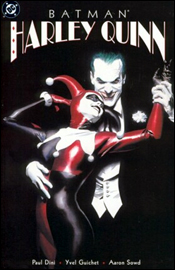 Batman: Harley Quinn
Batman: Harley Quinn
Writer: Paul Dini
Artist: Yvel Guichet
By Michael David Sims
If Mad Love served to show Harley Quinn as the quintessential victim of an abusive relationship and revealed her origin to the world, why would DC do it again five years later with a watered down version? Granted, Mad Love was meant to showcase an episode of Batman: The Animated Series that Paul Dini and Bruce Timm couldn't produce (at the time), and Batman: Harley Quinn was meant to finally transition the fan favorite into regular DC continuity. However, there was nothing inside the pages of Mad Love that made the story exclusive to the animated series. If DC wanted, they could have simply reprinted the book, slapped on an Alex Ross cover, and it would have sold like gangbusters. Instead, they took another stab at it and came up so very short — even when it's not compared to the classic.
The story opens as Poison Ivy discovers Harley buried under tons of wreckage, and (for whatever reason) decides to nurse the wounded Quinn back to health. As Harley licks her wounds, she broods over having broken up with the Joker and tells her origin to Ivy — making no bones about having slept her way through school. We see her early days as a young intern at Arkham, how she quickly fell for the Joker and helped him escape, and how she ended up in the asylum.
As she sat there, content in knowing her puddin' would one day return to rescue her, the days and months passed and her fevered love waned. Then, as luck would have it, an earthquake struck Gotham City (RE: Batman: No Man's Land) — cutting power to the locks that sealed her door. Upon finding an escape, Quinn quickly rushes into the heart of Gotham City, dons herself a costume, and finds Mr. J with ease.
(So let me get this straight. Harley finds one of the Joker's famous smiling victims, gets word that he needs supplies, learns who the only supplier in town is, and tracks both the supplier and her love down — all in a matter of hours. And they call Batman the world's greatest detective. Seriously though, if Quinn was able to uncover all of this, where was Batman or one of this ilk? I understand he fled Gotham for a period during NML, but the average reader doesn't. Yes — the Joker hints at this later, but what of those who weren't reading any of the Bat-books at the time, and picked this up as a back issue. I'm not asking for longwinded explanations of every last detail or those old, annoying notes that would clutter-up the bottom of panels, but something was needed here.)
The Joker, having himself a new henchgirl, lets her prance around and build him a new hideout, if only because she's useful — for now. When she stops being useful, well — we know what the Joker does to those who bother him. And that's where the book started — with Harley buried under tons of wreckage. Half — 24 full pages — of a 48-page book were gobbled up by what could have served as a compelling, thought-provoking four issue mini if done right. Instead, we get mediocre summery — and an Alex Ross cover. Pardon me while I roll my eyes and ask for my $5.95 back.
To top it off, the appearance of Poison Ivy serves as nothing more than a device to give Harley superpowers. Yes — superpowers. Nothing great — like the ability to tell DC they're dumbing down a tragic character — but enhanced speed, agility and strength.
So ol' Harl crafts some grand scheme to kill both Batman and the Joker, and from there on out it's pretty much Batman v the Joker, Harley v Batman, and Harley v the Joker. Typical superhero stuff. And, just when it looks like Harley will have her revenge on her former lover, he woos her once again — if only to save his hide — and the two escape, leaving Batman in the ashes of an explosion.
There you go, the much anticipated introduction of Harley Quinn into the DCU.
I hate to draw constant comparisons between Batman: Harley Quinn and Mad Love, but it's impossible not to. Even if I had not just reread Harley's other origin (which I gave a grade of 9.666), I still would have scoffed at this. Quite simply, it's lackluster and missing the edge that made Mad Love so damn sharp. Here, Harl plays the role of the annoying, clingy girlfriend. Frankly, we want the Joker to kill her, because we've all been there (even if you have to substitute boyfriend for girlfriend — no sexist remarks from me). Gone are her emotional and physical bruises, the traits that made her all the more tragic in Dini's other script.

